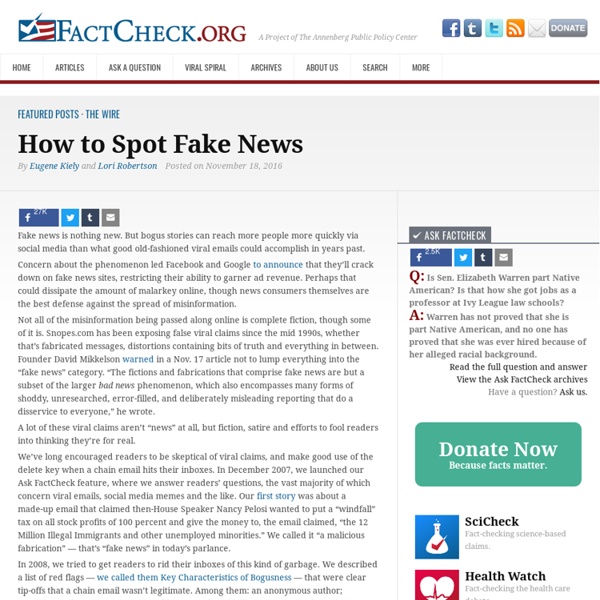Fake News Or Real? How To Self-Check The News And Get The Facts : All Tech Considered
Guido Rosa/Getty Images/Ikon Images Fake news stories can have real-life consequences. On Sunday, police said a man with a rifle who claimed to be "self-investigating" a baseless online conspiracy theory entered a Washington, D.C., pizzeria and fired the weapon inside the restaurant.
Special Report: The Changing Face of Literacy
There has never been a generation of young people more immersed in digital media than this one, many of whom learned to use a mobile device before they even started school. This special report examines how literacy instruction is changing in the digital age, from learning to sound out words in elementary school to grappling with “Macbeth” in high school. It finds that, while experts quibble over what it means to be digitally literate, they agree on one thing: even the youngest children should be learning literacy with a mix of print and digital texts. Is the digital revolution transforming literacy instruction in the nation’s schools? Should it?
Evaluating Sources in a ‘Post-Truth’ World: Ideas for Teaching and Learning About Fake News - The New York Times
Back in 2015, when we published our lesson plan Fake News vs. Real News: Determining the Reliability of Sources, we had no way of knowing that, a year later, the Oxford Dictionaries would declare “post-truth” the 2016 word of the year; that fake news would play a role in the 2016 presidential election; that it would cause real violence; and that the president-elect of the United States would use the term to condemn mainstream media outlets he opposes. Back then, to convince teachers that the skill was important, we quoted Peter Adams of the News Literacy Project on the “digital naïveté” of the “digital natives” we teach. Now, however, we doubt that we need to convince anyone. These days, invented stories created in a “fake news factory”— or by a 23-year-old in need of cash — go viral, while articles from traditional sources like The Times are called “fake news” by those who see them as hostile to their agenda. As always, we welcome your ideas; please post them in the comments.
Good Tools for Teaching Students How to Evaluate Web Content Credibility
Source: Butler University Library, adapted from Meriam Library at CSU, Chico One of my favorite lessons to teach is about evaluating the credibility of web sites and other digital content. I often start by showing the classic “Can't Lie On The Internet” video from AllState, which gets a laugh and helps to get students in the right mind set. Next, we check out the classic “DHMO” site and talk about what we see there.
How Photos Fuel the Spread of Fake News
During a campaign stop in South Carolina last winter, Hillary Clinton stumbled as she climbed the steps of an antebellum mansion in Charleston. Aides helped her regain her balance in a vulnerable but nondescript moment captured by Getty photographer Mark Makela. He didn’t think much of it until August, when the alt-right news site Breitbart touted it as evidence of Clinton’s failing health. “It was really bizarre and dispiriting to see,” he says.
After Comet Ping Pong and Pizzagate, teachers tackle fake news
History teacher Chris Dier was in the middle of a lesson last week at Chalmette High School in Chalmette, La., when a student made a befuddling inquiry: “He raised his hand and asked if I knew about Hillary Clinton using pizza places to traffic people.” About a thousand miles away at Wilson High School in Northwest Washington, distressed students in teacher Eden McCauslin’s history and government classes asked why a North Carolina man armed with an assault rifle had appeared at their local pizza shop, Comet Ping Pong, telling police that he wanted to free child sex slaves he believed to be harbored there, a false narrative conspiracy theorists have pushed on the Internet. [Pizzagate: From rumor, to hashtag, to gunfire in D.C.] Hoaxes, fake news and conspiracy theories have abounded on the Web, spreading with increasing speed and intensity during the recent presidential election cycle. As the Comet Ping Pong incident displayed, such false accounts can inspire very real consequences.
UM Library Fake News Course
The slides for the LOEX 2018 session entitled Fake News, Lies, and a For-credit Class: Lessons Learned from Teaching a 7-Week Fake News Undergraduate Library Course can be seen on the right. An open Canvas version of the course is available as well. Look for a Canvas version of the course in the Commons if you are a Canvas campus. The assignments in the Canvas Commons course take advantage of the integration of Google Drive and Canvas on our campus.
Critical thinking is a key skill in media and information literacy, and the mission of libraries is to educate and advocate its importance. Discussions about fake news has led to a new focus on media literacy more broadly, and the role of libraries and other education institutions in providing this. When Oxford Dictionaries announced post-truth was Word of the Year 2016, we as librarians realise action is needed to educate and advocate for critical thinking – a crucial skill when navigating the information society. IFLA has made this infographic with eight simple steps (based on FactCheck.org’s 2016 article How to Spot Fake News) to discover the verifiability of a given news-piece in front of you.


